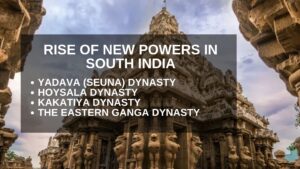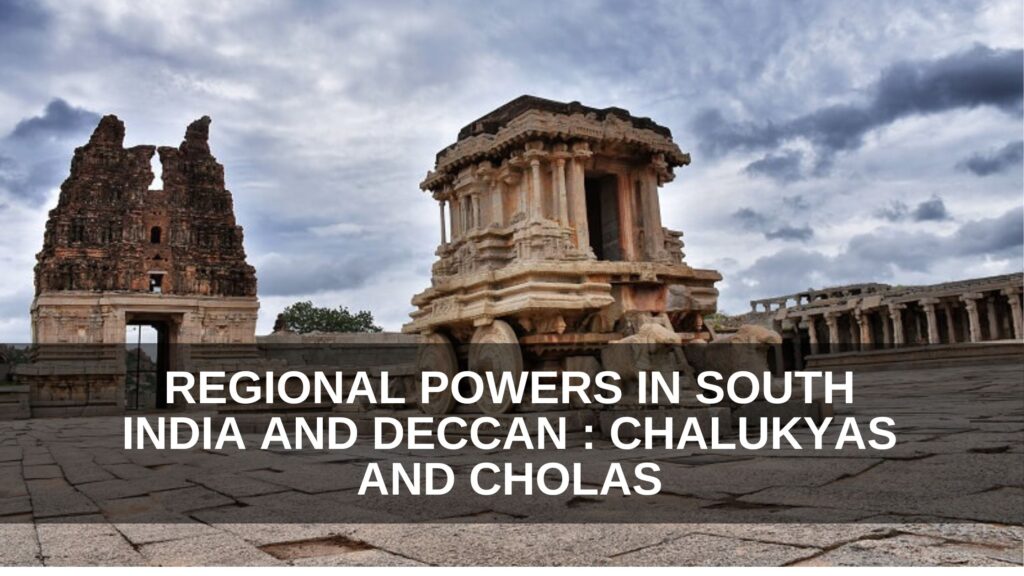The history of Regional Powers in South India and Deccan region witnessed a complex web of power struggles, dynastic rise and fall, and cultural advancements between the 10th and 14th centuries. After the decline of the Rashtrakutas, the Western Chalukyas and the Cholas dominated the Deccan.
However, their struggles with the Parmaras of Dhara and the Kalachuris of Tripuri significantly shaped the political landscape. This article explores the major regional powers that ruled the South Indian and Deccan regions before the advent of the Delhi Sultanate.
Regional Powers in South India and Deccan
The Western Chalukyas: Rise and Fall
Rise to Power
The Western Chalukyas emerged in the 10th century, taking control of the western Deccan region. They were originally feudatories of the Rashtrakutas. Around 957 CE, Tailapa II overthrew the Rashtrakutas and established the Western Chalukyan Empire, ruling from Kalyani in present-day Karnataka.
For nearly 200 years, the Western Chalukyas waged continuous battles against the Cholas and the Eastern Chalukyas of Vengi, primarily over the control of the fertile Vengi region.
Download notes of Evaluation of Rajput States
Sources of Western Chalukyan History
- “Gada Yuddha” by Ranna – A major literary source by one of the earliest Kannada poets.
- Kannada Inscriptions – Numerous inscriptions on rocks and temples.
- “Vikramankadeva Charitam” by Bilhana – A Sanskrit prashasti dedicated to Vikramaditya VI.
Greatest Ruler: Vikramaditya VI (1076-1126 CE)
Vikramaditya VI, the greatest Western Chalukyan ruler, ascended the throne in 1076 after rebelling against his elder brother, Someshwara II. Under his leadership:
- The Chalukyas successfully fought the Cholas.
- Their territory extended between the Narmada River in the north and the Kaveri River in the south.
- Other Deccan powers like the Hoysalas, Seuna Yadavas, Kakatiyas, and Southern Kalachuris were subordinates to the Chalukyas.
Decline of the Western Chalukyas
- After Vikramaditya VI’s death, Vengi fell to the Later Cholas.
- The Hoysalas declared independence by the mid-12th century.
- The Kalachuris captured Kalyani in 1156, holding it for only 25 years.
- The Western Chalukyas briefly regained control but could never restore their former power.
The Kalachuris: From Feudatories to Rulers
Kalachuris of Tripuri
- Originally feudatories of the Rashtrakutas and Pratiharas.
- Gangeyadeva (1015-1041 CE) took the title of Maharaja and aided Rajendra Chola against the Chalukyas of Vengi.
- Under Lakshmi Karna (1041-1073 CE), the Kalachuris reached their peak, defeating the Chandellas, Palas, and Parmaras.
Kalachuris of Kalyani (1156-1181 CE)
- Overthrew the Western Chalukyas and ruled for 25 years.
- Their rule marked a significant socio-cultural shift as they patronized Lingayatism and Vachana poetry.
- After their rule ended, the weakened Chalukyas paved the way for the Hoysalas to gain prominence.
Rise of New Powers in South India

Yadava (Seuna) Dynasty
- Originally feudatories of the Rashtrakutas and Chalukyas.
- Bhillama V declared independence in 1187 CE, establishing the Yadava rule.
- Simhana II (1210-1246 CE) expanded the Yadava kingdom from the Narmada to the Tungabhadra.
Cultural Impact:
- Marathi became an official language.
- Saint-poet Dnyaneshwar composed Dnyaneshwari, a Marathi commentary on the Bhagavad Gita.
- Simhana patronized astronomy and literature, fostering works like Sangita Ratnakara by Sharngadeva.
Hoysala Dynasty
- Originally feudatories of the Western Chalukyas, they declared independence after Vikramaditya VI’s death.
- Vira Narasimha (1152-1173 CE) killed Tailapa III and established Hoysala rule.
- His son, Ballala II (1173-1220 CE), became the first independent ruler.
Religious and Cultural Contributions:
- Patronized three major religious movements: Lingayatism (Basava), Vishishtadvaita (Ramanuja), and Dvaitavada (Madhavacharya).
- Developed the distinctive Hoysala architectural style, with stellate (star-shaped) temples.
Kakatiya Dynasty
- Originally feudatories of the Western Chalukyas, they gained independence under Rudradeva I (1162 CE).
- Extended control over most of Andhra Pradesh, with their capital at Orugallu (Warangal).
- Rudrama Devi (1263-1289 CE) became one of the first female rulers of South India.
Cultural and Architectural Contributions:
- United Telugu upland and lowland cultures.
- Built the Pakhal Lake in Warangal.
- Kakatiya architecture produced remarkable works like the Thousand Pillar Temple and the Ramappa Temple (a UNESCO heritage site).
The Eastern Ganga Dynasty
- Ruled Kalinga (modern Odisha) from the 5th to 15th century.
- Anantavarman Chodaganga built the famous Jagannath Temple in Puri.
- Narsimhadev I constructed the Konark Sun Temple to commemorate his victory over Bengal.
Cultural Contributions:
- Promoted the Kalinga architectural style, a sub-school of the Nagara style.
- Their coins, called Ganga Phanam, influenced regional economies.
Literature and Architecture in South India
Marathi Literature:
- Saint-poet Dnyaneshwar’s Dnyaneshwari remains a crucial literary work.
Kannada Literature:
- Pampa, Ponna, and Ranna, the “Three Jewels of Kannada Literature.”
- Ranna wrote Gada Yuddha.
Telugu Literature:
- Nannaya Bhattaraka translated the Mahabharata into Telugu.
- Recognized as the Adikavi (first poet) of Telugu literature.
Download notes of The Great Rajput Dynasty
Architecture:
- The Vesara style blended Nagara (North Indian) and Dravidian (South Indian) styles.
- The Chennakeshava Temple of Belur and the Hoysaleshwara Temple of Halebid are prime examples.
By the 14th century, the regional kingdoms of South India fell to the Delhi Sultanate, starting with Alauddin Khalji’s invasions and later conquests by Muhammad-bin-Tughlaq. However, the legacy of these powerful dynasties continued through their rich cultural and architectural contributions.
Their decline paved the way for the rise of new powers, such as the Vijayanagar Empire and the Deccan Sultanates, which would shape the region’s history in the coming centuries.


